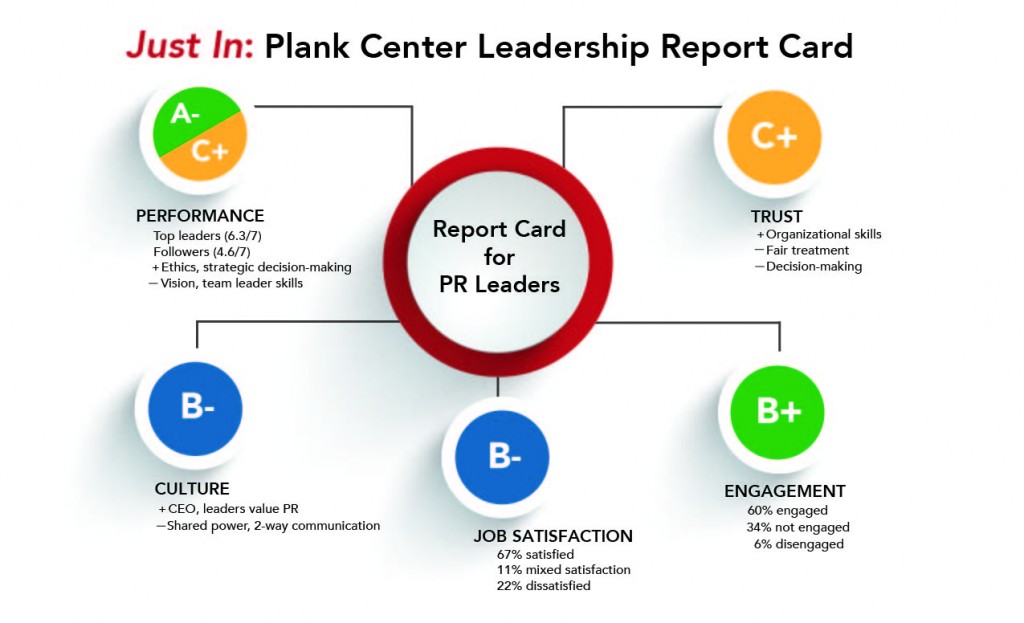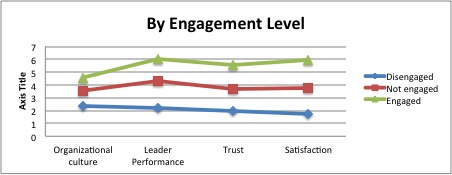Grades for trust, engagement, job satisfaction and culture vary by gender, rank and organizational type
The first Plank Center Report Card on communication leaders highlights a Grand Canyon-sized gap between leaders’ evaluations of their own performance and those of their employees. Leaders earned high marks for work engagement, but lagged in job satisfaction, work place trust and culture.
The grades are based on a survey* of 838 U.S. public relations executives and managers that was conducted by The Plank Center for Leadership in Public Relations and Heyman Associates. Survey participants rated the performance of their top PR leader and the quality of their work place culture, and then evaluated their own levels of work engagement, trust in their organization, and job satisfaction. Grades were assigned based on mean scores for professionals’ responses.
“Our goals with this biennial report are to assess the state of leadership in the field and identify gaps, or opportunities to enrich the development of communication leaders,” said Bruce K. Berger, Ph.D., research director of The Plank Center. “If we know where the gaps are, we can work to close them and to strengthen the overall quality of our profession’s leadership—a crucial strategic asset.”
William Heyman, president and CEO of Heyman Associates, said, “The Plank Center is using these and other findings to open dialogues with the PRSA College of Fellows, the Public Relations Student Society of America, and other groups to enhance the development of young leaders for a dynamic but uncertain future. We embrace that challenge and urge others to join us.”
The Grades
Job Performance of the Top Leader (A-/C+)
Leaders’ and followers’ perceptions of the top leader’s performance differed sharply: Leaders gave themselves an “A-,” while followers gave them a “C+.” Leaders received high marks for ethical orientation and involvement in strategic decision-making but earned lower marks for their vision, relationship-building skills, and team leadership capabilities.
“This gap doesn’t necessarily mean that leaders are ineffective,” Berger said. “Employees may be upset about other issues in their lives, or unhappy with a recent assignment or work review. But closing the gap is nevertheless important because leaders influence all other issues in our study.”
Work Engagement (B+)
Sixty percent of PR leaders were engaged in their work, 34% were not engaged, and 6% were disengaged. Based on previous Gallup Q12 studies, more PR leaders were engaged, and fewer disengaged, than leaders in many other professions or organizations. High-ranking and long-service professionals were most engaged; women were a bit more engaged than men. According to Gallup’s State of the American Workforce Report (2013), organizations with more engaged employees enjoy higher productivity, profits and service ratings, and lower absenteeism and turnover.
Trust in the Organization (C+)
Trust received the lowest grade and was an issue at all levels, though lower-level PR professionals were more distrusting. Professionals trusted their organization’s capabilities to compete successfully and achieve its goals, but expressed less trust in their organizations to keep promises and to be concerned about employees when making important decisions. Trust is crucial in building and sustaining relationships. Leaders influence trust and engagement through their communications and behaviors, which help shape the extent to which an organization’s culture is supportive and open.
Job Satisfaction (B-)
Two-thirds (67%) of PR professionals were satisfied or very satisfied with their jobs; 11% were neither satisfied nor dissatisfied; and 22% were dissatisfied or very dissatisfied. Top leaders were more satisfied with their jobs than those at all other levels. Agency PR professionals were most satisfied compared to those working in companies or nonprofits. Job satisfaction is strongly affected by engagement and trust, which are strongly influenced by leaders and organizational culture.
Organizational Culture (B-)
Culture refers to the internal environment, processes and structures that help or impede communication practices. The CEO’s understanding and valuing of public relations was rated highly, while that of other functional leaders was rated lower. Shared decision-making practices and the presence of two-way communications and diversity were graded far lower. Top leaders rated cultural factors higher than those at other levels. Women rated most cultural factors lower than men—and shared decision-making power a great deal lower. Agency professionals rated culture highest among organizational types.
Four Gaps—Implications
The study revealed four gaps that PR professionals and their organizations must reduce to strengthen leadership, communication practice, and results for their organizations:
- The perceptions of top leaders and followers. Top leaders rated their performance, trust, work engagement, job satisfaction and organizational culture significantly higher than followers at all levels. Things look different—and far better—at the top. Leaders may often rate their own performance higher than do followers, but the size of the gaps in the study is substantial. Leaders can reduce the gaps by 1) increasing power sharing, 2) strengthening two-way communications, and 3) enhancing interpersonal skills to enrich relationships and team work.
- Existing culture and a culture for communication. Several issues—lack of 2-way communication, limited shared power in decision-making, and concerns about diversity—point to differences between professionals’ organizational cultures and an ideal type referred to as a culture for communication. This is characterized by: 1) an open communication system; 2) dialogue, discussion and learning; 3) the use of two-way communications; and 4) a climate in which employees can speak up and be listened to, without fear of retribution. PR leaders can be change agents and work with others to reduce or eliminate restrictive actions, practices, and structures in the culture.
- Professional women and men. Their perceptions of work culture, shared power, 2-way communications, and the valuing of their opinions differed sharply. Women seek more involvement in strategic decision making, they want their opinions to count for more, and they advocate for a more open communication system and climate. Because top public relations leaders hold decision-making power over some inequities in the field (e.g., pay and promotion) and exert influence on many others, they can close these gaps.
- Agencies and other organizational types. Professionals working in agencies rated most items and categories higher than other organizational types. The Gallup Report indicated that engagement levels are often higher in smaller work teams, which may be more characteristic of agencies. In addition, an organization with a CEO who is likely a communication professional, and employees who are largely communication professionals, may provide a clearer vision, mission and objectives. The agency structure and culture should be examined to identify best practices.
The Power of Engagement
Berger said the strong grade for engagement provides a foundation for improvements in two ways: 1) Top leaders and front-line managers strongly influence engagement levels through their communications and interactions with others. Highly engaged leaders can energize and inspire greater discretionary efforts. 2) Engagement is key driver that strongly links to each of the other issues in the study, as indicated in the following chart:
Here, engaged PR professionals held more positive perceptions of all four issues: they viewed their organization’s culture as more supportive, rated leader performance higher, placed greater trust in their organization, and expressed greater job satisfaction.
The study also found that engagement is strongly influenced by supportive organizational culture and excellent leadership. The predictive model below indicates that culture and leadership very strongly influence each other. In turn, they exert strong influence on employee engagement and moderate influence on work place trust. Engagement exerts strong influence on trust, and both engagement and trust strongly influence professionals’ job satisfaction.
“Employee engagement is both a key outcome and a powerful driver,” Berger said. “Engaged employees are productive workers and positive influencers and role models.”
Background & Demographics*
The Survey
A 39-question survey was distributed online to about 17,000 PR leaders and managers, and 838 completed the survey. This response provides a 99% confidence level (+/- 5%) that the results represent the larger population of surveyed professionals.
Demographics
Most participants were senior leaders and managers: 75% of the 838 respondents were the #1 or #2 communication professional in their organization; 60% had more than 20 years of experience; and 90% had 11 years of experience or more. A few more women (429 or 51.2%) than men (409 or 48.8%) completed the survey. The majority of participants worked in public (341 or 40.7%) or private (110 or 13.1%) corporations, followed by nonprofits (228 or 27.2%), communication agencies (114 or 13.6%), and others (45 or 5.3%).
Many respondents indicated they belong to professional associations. Those mentioned most often were: PRSA (349), IABC (130), Arthur W. Page Society (71), IPRA (32), PR Council (30), and the American Marketing Association (22). Collectively, 94 different associations were named, but nearly one-quarter (24.1%) said they didn’t belong to any professional association.
About The Plank Center for Leadership in Public Relations
In 2005, the University of Alabama Board of Trustees established The Plank Center, named for public relations leader and UA alumna, the late Betsy Plank, to develop and recognize outstanding diverse public relations leaders, role models and mentors to advance ethical public relations in an evolving, global society through a variety of programs, and in concert with groups and associations.
In addition to national leaders in the practice and education, the Center Board includes an ex officio position for the president of the Public Relations Student Society of America that represents more than 11,000 members in 300-plus colleges and universities.
The Center is housed in UA’s College of Communication and Information Sciences. UA’s public relations program, with nearly 1,000 students, is the largest undergraduate degree program within the College. The program is certified by the Public Relations Society of America and for six years has been ranked among the top five public relations programs in the country by PRWeek magazine.
More information about The Plank Center for Leadership in Public Relations can be found at http://plankcenter.ua.edu/.
###


